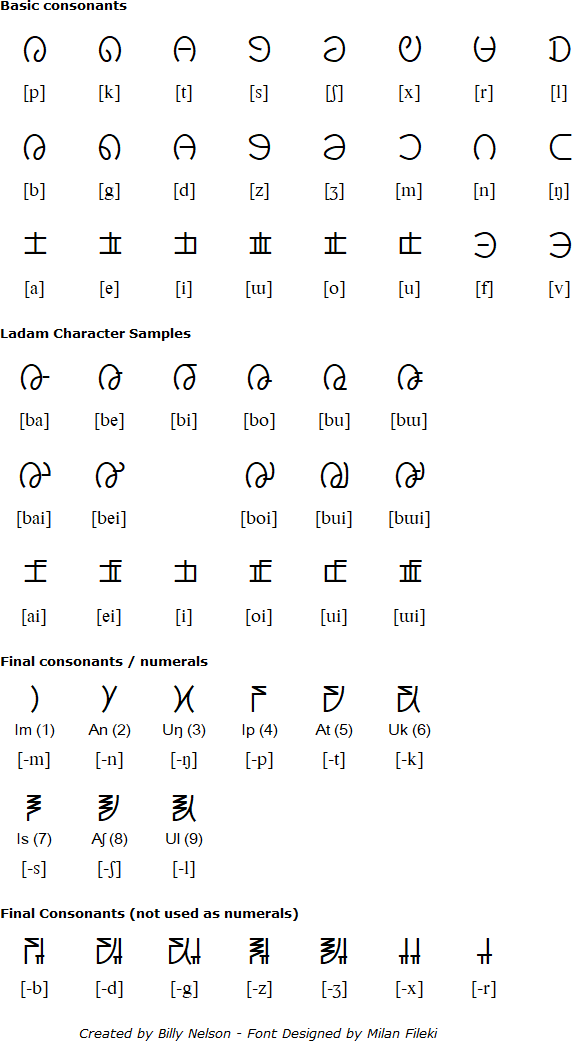The Ladam script was created by Billy Nelson to write Tarim, his constructed language. Hangeul was a major inspiration for the Ladam alphabet. Like Hangeul, most Ladam characters are taken from the positions made by the tongue, lips, or throat when saying certain sounds. Still, Ladam retains its own logic to effectively encode various words or phrases.
Each character represents a consonant, vowel, or consonant + vowel. There are over 500 syllabic characters encoded by basic Ladam consonants and vowel strokes. These characters are used up until the end of a word. If the final letter of a word is a consonant, that letter is written as a number. (If it is not a consonant, nothing changes).
Since every number in spoken Tarim contains a different consonant, numbers (when placed at the end of a series of characters) represent final consonants. Because numbers can form final consonants, it becomes easier to distinguish where words end and where others begin.
The Ladam alphabet itself is easy to learn, and new letters are easy to implement based on logical patterns of consonants and vowels. Therefore, it would be easy to adapt Ladam to write another language.

Download a script chart for Ladam includes information about Tarim pronouns and constructing basic sentences (Excel)
The most common format for Tarim sentences is the Subject, Object, Relationship, Verb format (SORV), where both subject and object are optional.
A sentence in Tarim always has at least one verb, and one relationship determined by a relationship pronoun. Relationship pronouns in Tarim tell the subject, tense, and object of the sentence. Consider the following English sentence: “I love you.” In this short English sentence, there are three words: a subject pronoun, a present tense verb, and an object pronoun. The same sentence could be written in Tarim as “Pan miŋ.” The relationship pronoun in this sentence is “pan.” The verb for love, “miŋ,” only serves as an action and has no tense whatsoever.
Relationship pronouns are formed by taking the first letter of the pronoun of the subject, placing a vowel for tense (“a” for present tense, “o” for future tense, “ɯ” for past tense), and concluding with “m”, “n”, “ŋ”, or “i”, depending on the object. You can view a comprehensive list of relationship pronouns below.
Once a relationship pronoun and verb are chosen, then one can expand the sentence by specifying what the subject or object actually is. Consider the sentence “Kai ket.” We can break up “kai” into “k” + “a” + “i.” These three letters tell us respectively that “The subject is he/she,” “The tense is present,” and “the object is it.” The verb “ket” means “has.”
So, this sentence can mean “She has it.” This sentence is grammatically correct, but it is vague. To make it clearer, we can include a subject and object: “Auta kai ket” translated as “She has a car.” We could even take it a step further and say: “Anna auta kai ket.” translated as “Anna has a car.”
When writing a sentence, sometimes there are multiple subjects or objects. In English, there is the conjunction “and” but Tarim has no such conjunction. Instead, Tarim uses numbers at the end of a chain of subjects or objects to group that chain as one. Consider the following English sentence: “The mountains are tall and amazing.” This would be translated as “Xotalgo xoik otamik an gai nar.” The word “an” is translated as “two.” This number is used after the two adjectives “xoik” and “otamik,” to group both as the object of the sentence. If there were three adjectives, they would be followed by “uŋ,” four would be followed by “ip,” and so on.

Pek uazim hami biarik tezim imikagaim dɯik domen dɯik ʃanirim gɯi ket. Ilo moraim bisa ʃ an kɯi ʃak biarik tezim mi ak kid ik mekim tezim gai kalaŋiksal ik kekim gai zal.
All human beings are born free and equal in dignity and rights. They are endowed with reason and conscience and should act towards one another in a spirit of brotherhood.
(Article 1 of the Universal Declaration of Human Rights)
For further information, you can contact Billy Nelson at al.sm.mdr@gmail.com
Constructed scripts for: Ainu | Arabic | Chinese languages | Dutch | English | Hawaiian | Hungarian | Japanese | Korean | Lingala | Malay & Indonesian | Persian | Tagalog / Filipino | Russian | Sanskrit | Spanish | Taino | Turkish | Vietnamese | Welsh | Other natural languages | Colour-based scripts | Tactile scripts | Phonetic/universal scripts | Constructed scripts for constructed languages | Adaptations of existing alphabets | Fictional alphabets | Magical alphabets | A-Z index | How to submit a constructed script
[top]
You can support this site by Buying Me A Coffee, and if you like what you see on this page, you can use the buttons below to share it with people you know.

If you like this site and find it useful, you can support it by making a donation via PayPal or Patreon, or by contributing in other ways. Omniglot is how I make my living.
Note: all links on this site to Amazon.com, Amazon.co.uk
and Amazon.fr
are affiliate links. This means I earn a commission if you click on any of them and buy something. So by clicking on these links you can help to support this site.
[top]